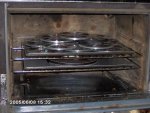(Beck, I found this comment of yours in another thread. It's the closest thing that *may* relate to my problem. Would you please comment on it?)Beck said:...After I bake a tape I run it through my machine in FFW while gently holding a lint-free cloth against the tape on the supply reel side. The cloth is full of oxide after the process and only then will I use the tape on the machine. Otherwise I would be cleaning all that crap off the heads. Even though baking fixes the sticky problem, there is still usually a lot of loose oxide left behind.
Have done research on this board and elsewhere to embrace the Ampex Grandmaster 456 "shedding and baking" matter.
Bought bunches of 456 in '85-'86, and recorded on all within a few years. Am now seeking to play & digitize after storing for most of these years. 4 years ago, ignorantly attempted to play one and saw oxide buildup immediately. Local guy informed me of Ampex binder problem. Back into storage til now. Need to downsize and get rid of tapes, but not the content.
Here's what I've done so far: 10.5" pancakes were stored slow-wound on mostly metal but some plastic reels. Have now baked 16 hrs at about 130 degrees in a gas-powered home oven (no flipping). In two cases, I "played" a tape before baking. That is, I threaded it on my Technics RS1506 capstan-only (bypassing the headblock), and after a very short time (minute or two?) saw bad oxide buildup (brown).
After baking (and letting cool down a few hours), I can do the 15ips pass thru the 1506 in headless fashion and get *no* brown oxide buildup at all. (Yea!!) However, during both passes, the black *backing* partially shaves off and accumulates as black powdery flecks on the upper guides (particularly the right one) as well as falling to the table both as flecks and (sometimes) little corkscrew shavings that fall apart when you touch them. Somehow some of the black is getting on the big capstan and requires effort to get it all off after each 30 minute 15ips pass.
As this is backing only, I haven't been too worried; the oxide is great and does play again. I've been playing the tapes on Tascam 34 (ch 1 & 3) into computer. If I have done the 2 passes thru the 1506 (minus heads) at 15ips, then I get no shedding whatsoever on the 34 unless I ff/rew in which case I get a *little* black backing shed.
I thought things were going great. Was not really monitoring the dubs; was spot checking the resulting wav files. I started monitoring by headphones, and was horrified to find occasional dropouts. This is the kind of dropout where you lose the treble in one channel, it clears up (maybe) in a few seconds, you rewind and play the segment again and no dropout. I got to thinking. Seems like the tape may be *dirty*. Have never had dirty tape in all the years I did R-R (1972-1989 in spells). Furthermore, I have reason to believe that this one tape in particular has never been played since it was recorded in '87. And it was the only recording ever made on the tape. So how could it get dirty?
It was a mystery as to why the black buildup on capstan was happening when it's the *oxide* side (brown) that contacts the capstan. Between this and my sporadic "temporary" dropout problem, I'm suspecting that *backing* from an adjacent tape layer is contaminating the oxide side of the tape. If this is the case, then I'm in real trouble, as all the digitizing done so far (without real-time monitoring) is suspect, and all must be re-done to catch dropouts. But I really need to stop those dropouts. Bad enough if I had to monitor all in real-time, but even if I do, I don't have enough time to digitally splice all the retakes.
Is there something that can be done to stop the backing from flaking off at all? The baking has stopped the oxide; what about the backing?
Also realize I have to deal with the backing that's *already* contaminated my oxide. I've read that I can use a standard 3% hydrogen peroxide to clean both tape sides. Have visualized holding cotton swabs soaked w/peroxide against both sides of tape as it does 15ips pass through my Technics RS1506.
I realize all this is old hat for most folks. Have searched around the web, but haven't been able to find how to deal w/backing flake-off. Can anyone here advise? Thanks!


